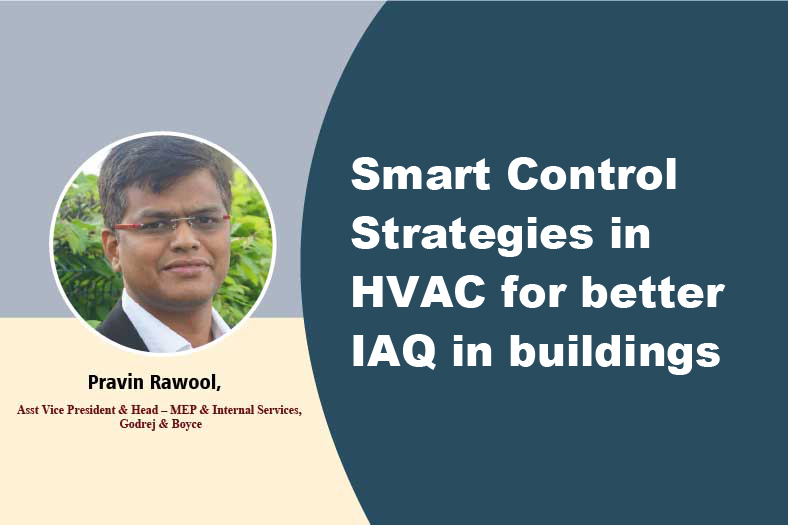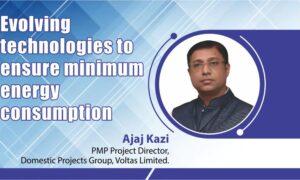Filtration, irradiation and ionised purifier methodologies improve IAQ.
Your views on the current status of the global thermal control technology market during changing times of unlock phase.
The Covid pandemic has begun to recede as the unlock phase progresses across the country. During this time, there has been substantial growth in markets across the globe. Thermal control is a prime factor affecting the occupants’ health. The demand for thermal control solutions and systems in HVAC sectors & managing IAQ for end-use industries such as healthcare, automotive, malls, supermarkets, libraries, museums, servers and data centers, railways and airports have led to the growth of the thermal control management market. Prior to Covid, limited importance was given to thermal control including IAQ; however, post Covid, the landscape has changed.
Your say on thermal control monitored through BMS and Energy management systems for determining HVAC specifications and employable thermal control technologies.
Migration from manual to automated data recording is the first step towards having better thermal control. Energy management systems (EMS) or Building Management Systems (BMS) are computer-based systems that automate your controls, measure your energy consumption and look for potential areas to improve thermal control and energy efficiency. They can help to monitor device level equipment of HVAC. It provides a big picture of your energy consumption, with the option to drill down to device level data. Once we have the overall idea on individual units of the HVAC system, we can dive deep to identify the present level of parameters affecting thermal comfort and accordingly, strengthen feedback and correction mechanisms. These systems can also help in identifying trends & loading patterns of equipment, and load diversity of your proposed / designed HVAC system based on realistic forecasts.
Today, thermal control technologies are quite robust and effective – you can integrate energy meters, BTU meters into your HVAC system that are also compatible with BMS and provide daily alerts. Such control measures are very well employable.
One must look at the present thermal comfort levels and implement EMS / BMS to have better thermal control. With this information, the HVAC designer can decide on the requirement of BMS / EMS as per the specifications for the upcoming HVAC systems.
Role and strategies for IAQ and filters in the HVAC scheme of things to deal with a healthy environment.
There are various indoor air quality (IAQ) parameters that contribute to thermal comfort namely – particulate matter, CO2, VOC concentration and microbe count. Filtration, irradiation and ionised purifiers, are the methodologies adopted to improve the IAQ and filtration is the most common strategy followed by irradiation. Many technical Indian & Western Institutions have also recommended the use of fine grade (MERV13 or higher) filters to tackle the pandemic & also create a healthier environment. ASHRAE 52.2 entails the MERV ratings and their efficiencies. We at our Godrej & Boyce campus have also deployed these strategies as was shown during the panel discussion – viz. retrofitting the existing AHUs with MERV 5, 8 & 13 filters and UVGI. The results of our pilot project were extremely encouraging and hence we have replicated it pan India for our offices and branches. Such schemes need to be implemented in the current situation to develop a healthy environment for the occupants.
Unique challenges you envision for maintaining occupants’ well-being and comfort inside the building? What factors and/or solutions need to be considered?
There were various challenges envisioned and mitigated during the retrofitting of HVAC systems for maintaining the occupants’ well-being and comfort. To begin with, the feasibility of the system needed to be studied. Also, the higher grade filters occupy extra space in the AHU rooms so one needed to check the available space prior to the retrofit and account for alternate measures like filter cabinets at Tier – II of the AHU needed to be evaluated and implemented, if the space was a constraint. Also, the fan & motor performances needed to be evaluated with the increased static pressure for viable operation.
Finally, in the absence of standard testing protocol, we carried the testing from third party accredited laboratories. Such alternate solutions were identified and deployed to not compromise the safety and health of the occupants.
Exchange of indoor and outdoor fresh air is imminent in public places and buildings, your views.
Fresh air is naturally rich in oxidants and so introduction of the outdoor air is an important factor in promoting good air quality in air conditioned public spaces. It helps to remove or dilute indoor airborne pollutants coming from indoor sources. This reduces the level of contaminants and improves indoor air quality (IAQ).
Furthermore, not only does one have to monitor the fresh air and recirculation air rates with respect to design application but also review the quality of air present outdoors. If the quality is unacceptable, then the outdoor fresh air needs to be treated, using passive &/or electrostatic filters, or employing Treated Fresh Air units. Hence, the higher ventilation rates supplying more outdoor air are associated with less absenteeism, fewer symptoms of sick building syndrome, and better performance on standardised cognitive tests making it extremely imminent especially in large public places and buildings as the quantum of occupants at stake is large.
Your views if advanced cooling technology could use automation in extracting and conditioning heat generated from HVAC systems for temperature conditioning of indoor spaces in large public spaces or buildings?
The HVAC industry has immensely progressed since the invention of the first electric furnace in 1861. From burning of wood to next-gen AI-based automated heating systems, the race towards smart, intelligent, fully automated HVAC technologies is still on.
Earlier, the sensing devices like thermostats, RTD sensors etc, were used to be integrated with an intelligent Building Management System (i-BMS) to achieve the desired level of thermal comfort. Nowadays, the advanced cooling systems themselves are smart, robust and compatible to integrate automation. Advanced cooling technology in itself cannot result in the desired level of thermal comfort but advanced cooling technologies with smart control strategies enable the true potential of the equipment; like water temperature reset control strategy, behave automatically based on climate conditions, preferences, and settings. Hence, the advancement in technology not only aids in the proper extraction of the heat generated indoors and temperature conditioning of indoor public spaces but also helps in precise control over the equipment and drives us towards energy efficiency & sustainability.
Opportunities for existing players and for those planning to enter various stages of the thermal control technologies supply chain market?
According to third party research data, the global thermal management market is estimated to be USD 12.8 billion by 2025 (forecast year) from USD 8.8 billion in 2020 (estimated year), at a CAGR of 8.2 percent between 2020 to 2025. Given the situation posed by the COVID pandemic, the current market is dynamic in nature and this influences the future growth of the supply chain. In such a scenario, proper identification of thermal management technologies and products with the greatest commercial potential must be done to enter the supply chain market for thermal control. Thermal control technologies evolve rapidly and this pandemic has created many opportunities for existing as well as new players to compete in the thermal control supply chain market. Like, there’s an increase in demand for fine filters, UVGI etc. so in turn the respective OEMs had got a huge market share.
Innovative opportunities and challenges in HVAC design and consulting for big public places in new normal times?
The HVAC industry has changed the way buildings are designed, erected, and used. Subsequently, modern technological developments have reshaped how these systems are installed,operated, and maintained. The result is an unprecedented standard of HVAC systems which are now turning smaller, smarter and more efficient than ever seen before.
Earlier, thermal properties of air within a zone determined HVAC specifications. Presently, occupant-specific and highly responsive systems are the norm. Natural ventilation, displacement ventilation, micro zoning with subfloor plenums, and the use of point of source heat control and point of use sensors, are evolving to create a “smart” responsive ventilation building dynamic system.
It is also observed that smart building technology can help customers operate more efficiently and effectively. To sustain occupant well-being, building conditions must be continuously monitored and BMS controls adjusted taking account of balancing IAQ and comfort against energy efficiency and costs.
There are large opportunities for highly precise, inventive and energy efficient HVAC design and ancillary solutions for building services in a wide range of sectors including industrial, hospitality, commercial, healthcare, pharmaceutical, IT, warehouse and residential. However, we have observed that the control industry will require a shift with their strategies to operate all these HVAC equipment. With improved control and pool of technologists, the green perspective shall arrive to the HVAC industry along with improved thermal comfort.
Cookie Consent
We use cookies to personalize your experience. By continuing to visit this website you agree to our Terms & Conditions, Privacy Policy and Cookie Policy.















